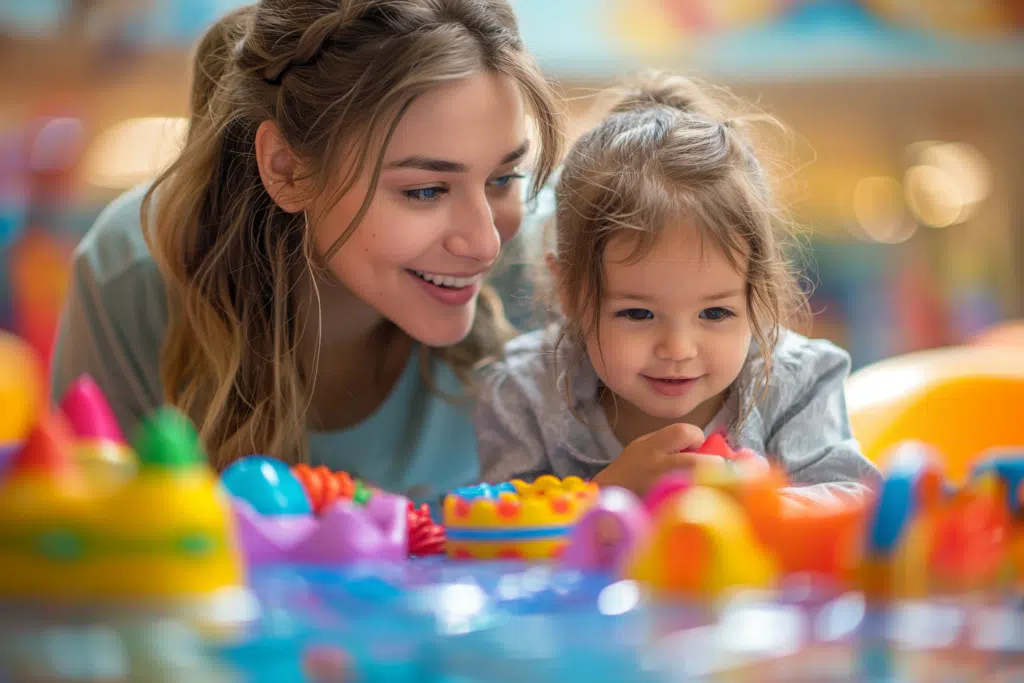A day in the life of a pediatric therapist at HHH Pediatric Therapy is exciting, rewarding, diverse and sometimes exhausting by the end of the day!!. Pediatric Occupational Therapists (OT), Speech Therapists and Physical Therapists (PT) spend their days using play to help children reach developmental milestones and learn skills that improve their lives.
Morning Preparations:
Most therapists arrive well before they start seeing their first client. They typically catch up on emails, answer voicemails, and think through their first few sessions. They can often be found setting up their treatment space for any games/activities they plan to utilize with their clients.
While treatment is most often child-led, therapists still spend a great deal of time thinking about activities that will best set up opportunities for a “just right” challenge for their client. Therapists must take into consideration the child’s age, developmental level and personal interests.
Therapy Sessions:
OT and PT sessions are most often 60 minutes in duration, while most speech sessions are right around 30 minutes.
Therapists typically pick their client up from their parents in the waiting room. During this time, parents often fill the therapist in on any new skills the child has learned, any challenges that occurred during the week and provide updates on how home programming is going. This is an important transition and can set the tone for the therapy session.
Sometimes, parents prefer to remain in the session during their child’s therapy session- this can be a good time for parents to learn strategies to use at home.
Therapy sessions are FUN and most children love coming to their therapy appointments. The child is typically involved in helping to plan the games/activities in the treatment session; however the therapists skillfully modify the child’s preferred play to specifically address the goals laid out in the child’s plan of care.
There are often several therapy sessions going on in our larger spaces which allows for natural social interactions and collaborative play between clients. The skill areas being focused on are dependent upon the therapist’s specific discipline. Some common treatment areas for each discipline are listed below:
OT: fine motor, gross motor, functional vision, reflexes, sensory processing, emotional regulation, handwriting, self-care, dressing.
PT: gross motor development, coordination, balance, strength/endurance, joint motion or protection, orthotic use, posture and positioning.
ST: expressive language, receptive language, social pragmatic skills, augmentative alternative communication, articulation
If the child’s parent hasn’t joined in the therapy session, children are brought back to the waiting room to find their parent (or whomever brought them to therapy). Therapists typically share about the session and include instructions on any home programming or strategies they would like the family to implement at home during the upcoming week.
Collaboration:
Collaboration is an important part of a pediatric therapist’s job. It is important to know how our clients are functioning outside of therapy and learn what environment the child is performing well and what environments present more of a challenge. Therapists are often able to provide other service providers with tips, tools and strategies to assist the child in different environments as well.
For example, it is very common for our therapists to talk with a client’s classroom teacher and make recommendations for environmental modifications or strategies they can implement in their classroom. Therapists also commonly collaborate with other therapists, school OT/PT/ST providers, parents and doctors.
Lunch:
Our therapists take a working lunch. During this hour, they can often be found collaborating with other therapists about clients, on a phone call collaborating with outside service providers or finishing the never-ending amount of paperwork that comes with the job.
Documentation:
Completing necessary documentation is often a therapist’s least favorite part of their job. Documentation allows therapists to not only document their sessions, but serves as a tool to measure functional gains and progress the client has made over time. There are several types of documentation the therapists are responsible for.
Daily Notes:
Therapists are required to complete daily notes after each session outlining what goals were addressed, how the child responded to the different tasks/activities completed and recommendations for the next session.
Plan of Care/Progress Notes:
Every 3 months, therapists are required to write up a progress note outlining how the child has progressed towards their goals during the duration of the 3 months. If the client has met some or all of the goals, the therapist will write up goals that are more challenging aimed at addressing the next skill in the developmental progression. After the plan of care is completed, it is faxed off to the child’s pediatrician for signature.
Evaluation:
When a new client is referred for therapy, an initial evaluation is completed. This allows the therapist to identify where the child is functioning along the developmental continuum and identify areas of strengths and areas of need. If appropriate, therapists attempt to use standardized testing during the assessment process (along with skilled observation).
Sometimes the child is not able to engage in formal, standardized testing, if that is the case, the therapist will utilize observation to form their professional opinions. It is important that the therapist gathers information from the child’s caregiver as well.
Following the evaluation, the therapist will form goals for treatment which are documented in the plan of care. It is important the caregiver is also involved in developing goals in collaboration with the therapist. The write up for these evaluations can be time consuming and often take 30-60 minutes or more.
Supervision:
Many of our therapists love to give their time/talents to support students in their professional growth. Having a student in the clinic gives students an opportunity to practice their skills and prepare for their first job. Supervising a student is a time consuming but rewarding task.
Our therapists at HHH Pediatric therapy play a crucial role in helping children grow and develop skills that they will need for lifelong learning and success. Their jobs require a combination of clinical expertise, creativity, patience and effective communication with both children and their families.

